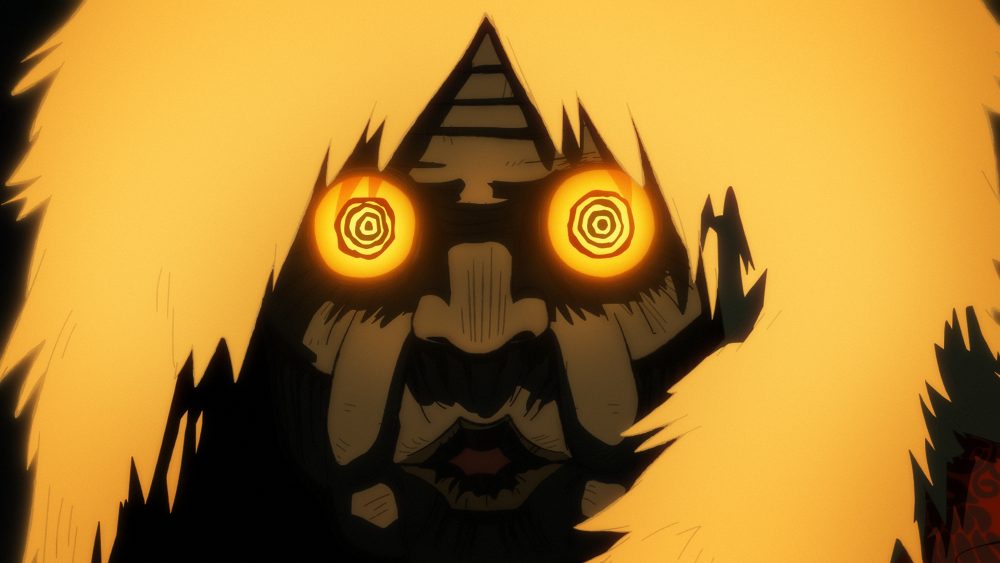|
Getting your Trinity Audio player ready...
|
Dan Da Dan, a quirky new series from the Science SARU studio, crosses so many genres, it’s actually quite difficult to categorize. Based on a manga by Yukinobu Tatsu that first appeared in Shonen Jump in 2021, Dan Da Dan is a rom-com involving a pair of oddball teenagers. But it’s also two intertwined horror stories: one involving a bawdy ghost that haunts an abandoned tunnel, the other featuring libidinous robots from the planet Serpo. (Dan is a noun used as a suffix that’s often appended to the titles of stories: A ghost story is a kaidan.) The first three episodes will debut theatrically on September 13, and the series will stream on both Crunchyroll and Netflix in October.
The story jumps between genres and moods rapidly, and sometimes joltingly from scene to scene. Fuga Yamashiro’s direction may remind viewers of a skilled juggler who somehow keeps an impressive number of balls in the air. He discussed the challenges and satisfactions of working on Dan Da Dan in a recent interview conducted via email.
“In taking this original work, which jumps genres at an astounding speed, and animating it, I thought it was necessary to emphasize its wide range,” says Yamashiro. “By creating ‘gaps’ in different places, you can show a wide variety of styles on screen, creating a good balance of the different genres and tempos, allowing each scene to stand out. That makes the whole series feel like a roller coaster. I think this relates to the lively emotions of the characters and the ever-changing nature of the original work.”
Momo Ayase is an outspoken, unpopular high school student who’s descended from a clan of psychics. She learned about psi power from her grandmother, a formidable “spirit medium” who performs exorcisms. When Momo comes to the aid of a nerdy guy who’s being taunted by bullies in class, she’s upset to learn his name is Ken Takakura.
In Search of Banana Organs
Momo is a superfan of the late actor Ken Takakura and refuses to accept anyone else having that name: She dubs him Okarun (from “occult”). He’s obsessed with aliens; she believes in spirits. An effort to prove each other wrong turns out disastrous: Okarun is possessed by Turbo Granny, a witch-like spirit; Momo is assaulted by alien robots. They must work together to undo their mistakes and return life to a semblance of normalcy. But their efforts to cooperate are complicated by fears, tantrums, frustrations and the first reluctant hints of mutual attraction.
The storyline is unlike anything in American animated series: Turbo Granny is after Okarun’s “banana organ”; the robots are tired of reproducing by cloning and want to experience heterosexual sex. The series is visually striking. The designs for Momo and Okarun are clean and straightforward with no unnecessary details.

Yamashiro says, “I asked the designers to reduce the ‘polygons’ as well as the amount of lines in the characters. In order to re-create the dense feeling of the original work’s artwork in the anime, I prioritized simple designs, so that characters could be moved more easily, and created additional supplementary density in visual style and direction.”
The designs support interesting animation. In contrast to the standard walk cycles of many anime girls, Momo drags herself from class to class with an odd, bowlegged gait. “By changing the movement of the character without changing the angle of the camera, I intended to bring out the repetitive feeling of Momo’s everyday life,” Yamashiro says. “The scene before starts with her completely sprawled over her desk, then shifts to her walking around like a zombie. Her bowlegged walk was one example of bringing out that feeling. I wanted to show that her rudeness and gloominess came out when she was by herself.”
‘By changing the movement of the character without changing the angle of the camera, I intended to bring out the repetitive feeling of Momo’s everyday life.’
— Director Fuga Yamashiro
In contrast to Momo’s bored-to-death-with-it-all shuffle, the Floodwoods Monster, a sumo wrestler spirit she and Okarun face, moves with powerful strides that conveys its weight and menace. “The Floodwoods Monster’s muscular body and lean, sharp silhouette were inspired by the champion sumo wrestler Chiyonofuji Mitsugu’s silhouette and poses,” adds Yamashiro. “The 3D character designer Louis Ventre did an incredible job on him. It’s one of my favorite creatures in the show! His entrance was based on sumo champion Harumafuji Kōhei’s Shiranui Gata.” (Shiranui Gata is a ceremony sumo wrestlers who have attained the highest rank perform when they enter the ring; it consists entirely of offensive moves.)
Yamashiro had to balance the often-frightening scenes against the slapstick moments that are an essential part of any rom-com. When a bored Momo makes faces and wiggles her fingers or when Okarun desperately needs a bathroom, the designs become simpler and the animation broad and cartoony.
Comic Reliefs
“To create gaps between the serious scenes, I made the directorial choice to incorporate comedic scenes,” Yamashiro says. “The simpler pictures bring out the directness of the emotions of the comic characters. However, I didn’t use more abstract backgrounds to go along with the simpler character designs, making sure to maintain a congruent base of reality, so it doesn’t feel chopped up. I was conscious of creating continuity in the visuals.”
The backgrounds also shift from everyday high school classrooms to eerie, crumbling structures to brightly colored graphic patterns, paralleling changes in mood and tone. “The idea of ‘gaps’ is one of the themes of this series, and I wanted to create some gaps on screen as well,” Yamashiro explains. “To depict the gap between everyday life and the extraordinary, I thought colors were a great weapon. The colors change in places dominated by yokai or aliens. The whole space is painted by a color as if it’s being lit by stage lighting.”
“Aliens give a cold impression and so I used cool colors; the yokai have a natural, rustic feeling to them and some contrasting warmth, so I used warm colors,” he continues. “Characters who gain powers from yokai carry that yokai’s theme color — it appears on certain parts of their body. In the second episode, in the black-and-white world of the Flatwoods Monster, the transformed Okarun’s red color (inherited from Turbo Granny) stands out: The visuals were calculated so that the red acts as an accent color within the black-and-white space.”
The first episodes of Dan Da Dan drew an enthusiastic response when screened at Anime Expo in July. Yamashiro concludes that he hadn’t thought much about international distribution when he was making the series: “I wasn’t particularly thinking about the nationality of the audience but rather about the fans of the original work. I think my duty was to capture the spirit and atmosphere of the original manga to the animation. However, the reactions I got from overseas fans at Anime Expo brought me a lot of joy and motivation.”
GKIDS will release the first three episodes of Dan Da Dan in theaters on September 13. The show will debut on Netflix and Crunchyroll in October.











 Win a Funko X Lilo & Stitch Prize Pack!
Win a Funko X Lilo & Stitch Prize Pack! 
